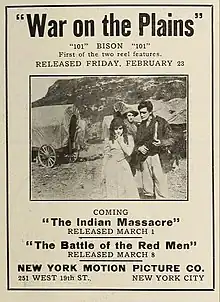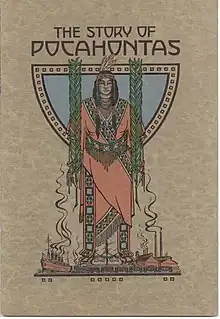Zintkála Nuni
Zintkála Nuni (Lakota: Lost Bird, 1890 – February 14, 1920), alternatively 'Zintka Lanuni', was a Lakota Sioux woman who was a 4-month-old infant when she was found alive among the victims at the Wounded Knee Massacre.[1]
Ziŋtkála Núni | |
|---|---|
"Lost Bird" | |
%252C_Found_On_Wounded_Knee_Battlefield%252C_South_Dakota%252C_1890_n.d.jpg.webp) Zintkála Nuni at 4 months old, held by her adoptive father, General Leonard Colby | |
| Born | Unknown 1890 |
| Died | February 14, 1920 (aged 29–30) |
| Resting place | Wounded Knee |
| Nationality | Sioux; United States of America |
| Other names | Margaret Elizabeth "Zintka" Colby Zintka L. Colby "Lost Bird" Maggie C. Nailor Brings White Horse Okicize Wanji Cinca |
| Education | Haskell Indian School, Kansas Chamberlain Indian School, Chamberlain, South Dakota Milford Industrial Home, Nebraska |
| Occupations |
|
| Employer(s) | Buffalo Bill Cody's Wild West Show and Sells-Floto Circus (1914-15), Pathe (1912) |
| Spouse(s) | Albert Chalivat, Robert "Bill" Keith, Dick Allen |
| Children | Three. Only surviving: "Clyde" (born circa. 1913). |
| Parent(s) | Unknown; adopted parents: Clara Colby and Leonard Colby |
Discovery and early life
_(page_5_crop).jpg.webp)
On the fourth day after the Wounded Knee massacre, when a US Army detail went out to bury the dead, Zintkála was found on the battlefield under a covering of snow, still tied and protected on her frozen mother's back. Although the exact member of the search party who found her is disputed, Charles Eastman and George E. Bartlett were among the physician team.[2] She, along with five other babies, were taken to the nearby Pine Ridge Reservation. Zintkála Nuni was found painted red, white, and blue by grease, used to protect the child against frostbite.[3] The baby was first cared for by members of the Lakota and she fully recovered from four days' exposure to freezing temperatures without food. Without knowledge of her identity or Lakota birth name, she was called Zintkála Nuni ("Lost Bird"). Zintkála Nuni received several other names within the first month of her discovery, including Maggie C. Nailor, Brings White Horse, Okicize Wanji Cinca, and Margaret Elizabeth Colby.[4] Bartlett took the child to Pine Ridge, where she was cared for by Native American resident Annie Yellow Bird. Buffalo Bill Cody, alongside press agent Major John Burke also took interest in the baby, arranging for her to be given to the Nailor family in Washington DC. The child was baptized Maggie C. Nailor in preparation to be adopted by Mrs. Allison Nailor, a wealthy business socialite friend of Buffalo Bill Cody.[5]
The child gained the interest of General Leonard Wright Colby in January 1891. When it was arranged that Colby should take custody of the child, Annie Yellow Bird took Zintkála Nuni to the nearby hostile Indian camp. Colby, intent on taking his 'prized relic', disguised himself as a half-blood Seneca Indian and rode into Red Cloud's camp to demand the child.[6] Zintkála was then taken by Colby by train to his home in Beatrice, Nebraska as a relic or "curio" of the massacre. Zintkála Nuni's heritage was consistently disputed, a factor which promoted Colby's swift return to the east and subsequent adoption on January 19, 1891, naming her Margaret Elizabeth Colby, after a townswoman named 'Margaret' who had aided Colby in the child's abduction from Red Cloud's camp.[7]
Colby said about his new daughter, "She is my relic of the Sioux War of 1891 and the Massacre of Wounded Knee."[8] Upon his return to Beatrice, Colby held several large gathering to exhibit the child, receiving 2,000 visitors within 4 days.[9] Zintkala was raised by Colby's wife, Clara Bewick Colby, who was a suffragette activist and publisher of The Woman's Tribune newspaper.[1] Learning that a Lakota woman had said "Zintkála Nuni" [lost bird] when Colby took her away, Clara Colby called her "Zintka" instead of "Leonarda" as the Beatrice townsfolk used. Clara Colby and Lost Bird used the name 'Zintka Lanuni' in their correspondence.[10]
When Zintkála was 5 years old, General Colby abandoned the family, married Zintkála's nanny and moved to Beatrice, Nebraska.[11] According to her biographer, because she was raised by a privileged, white family yet was sent to segregated boarding schools for her education, Zintkála suffered through a childhood of prejudice and rejection by both relatives and classmates.[12] Due to Clara Colby's busy work life, Zintkála spent her school years at various Native American boarding schools including Haskell in Kansas and Chamberlain in South Dakota. She also spent a brief period on a farm owned by the Pope family in Madison, Wisconsin.[13] When Zintkala was 17 years old, Clara Colby decided Zintkála was too rebellious and sent her to live with her adoptive father. Soon after, Zintkala became pregnant. Although the father of her child is unknown, historian Joseph Agonito suggested that Zintkála was sexually abused by Colby.[14]
General Colby committed Zintkála to the Milford Industrial Home in Milford, Nebraska, a reformatory for unwed mothers, where her child was stillborn during the first month of her arrival. She stayed there for a year; normally women were committed to the institution for a year via a court order; Joseph Agonito suspects that Colby used his political influence to have her committed for a year and thus keep the affair quiet.[14]
Occupation


Zintkála Nuni worked as a mascot for the Omniciye Tonka Lakota in March 1910, where she engaged in prostitution.[17] Zintkála was hired by Pathé in 1912 and involved in the following films: The Round-up, films for Essanay Pictures, Ammex Moving Picture Company and Thomas H. Ince: War on the Plains, The Battle of Red Men, and The Lieutenant's Last Fight, where she was an extra.[18] Later, she joined the Buffalo Bill's Wild West show, which had merged with Sells-Floto Circus for the 1914–15 season, before starting her own vaudeville entertainment business with husband and fellow-performer Dick Allen.[19]
Involvement in suffrage movement
From an early age, Zintkála Nuni had a personal column in the National Woman Suffrage Association's Woman's Tribune newspaper, entitled "Zintkála's Corner".[20] She accompanied Clara Colby in 1899 to London for the International Council of Women. She also portrayed Pocahontas at the 1915 Panama-Pacific Exposition in San Francisco.[21][22]
Identity struggle
During her youth, Zintkála Nuni was frequently visited by prominent Native American figures, including Hawaiian Queen Liluokalani, fellow Wounded Knee survivors, and Red Cloud.[23] Based on speculation that she may have been the daughter of Black-Day Woman, youngest wife of Sitting Bull, Zintkála Nuni often attempted to reach the South Dakota tribe with whom she most identified with. In one letter to Clara Colby, Zintkála Nuni wrote: "I want to go there [Standing Rock Reservation] very very much. ... I don't belong here [Chemawa Boarding School] anyway and these are not my tribe of Indians and I hate it here. S.D. was the only place I was ever really and truly happy and why can't I go back there. ... This comes from my heart and not from my lips only."[24] As biographer Renée Sansom Flood explains: "The cost of being taken from the Lakota was more than the loss of her language, her music, her food, her family kinship; it was the loss of her identity as a human being, the loss of her mind."[25]
Zintkála Nuni formed a close friendship with fellow Wounded Knee child survivor Mary Thomas.[26] She applied for citizenship of the Cheyenne River Sioux Reservation in December 1915.[27]
Later life

In December 1915, Zintkála Nuni's allotment on the Cheyenne River Sioux Reservation was sold without approval, provoking her and her third husband to move from a hotel room to his parents' home in Hanford, California three years later.[11][27] Due to poverty and Allen's illness, Zintkála engaged in prostitution to raise funds. During this time, her husband and one child died.
Zintkála Nuni's illness gradually worsened throughout her life. She became blind in one of her eyes, skin blotched, and had affected organs.[28] On February 14, 1920, Zintkála died of a heart failure, complicated by syphilis, during an epidemic of Spanish influenza.[11][29] She was buried in a pauper's grave in Hanford, California.
Personal life
Marriages
Zintkála returned to her adoptive mother who now lived in Portland, Oregon where she met Albert Chalivat, who she married the day after they first met. The marriage took place in Washington because of miscegenation laws in the state of Oregon preventing Native American and Anglo-American inter-marriage.[30] The couple soon became estranged when it became apparent that Zintkála had contracted syphilis, most probably from Colby's sexual abuse.[31] With no affordable cure for syphilis in 1909, Chalivat turned to alcohol and the couple separated after two weeks of marriage.[32]
During her career in Hollywood, Zintkála Nuni married actor Robert 'Bob' Keith on May 31, 1913, in Santa Ana. Zintkála Nuni married under her stage name "Princeton Davis" since the previous marriage with Chalivat had not been annulled.[33] Suffering abuse, Zintkála Nuni left in October 1913 with her child "Clyde".[34]
In March 1915, Zintkála Nuni married fellow circus performer Dick Allen, with whom she had two more children.[19]
Children
Nuni had three children. The first died on April 22, 1908, in the Milford Industrial Home. Her second son, Clyde, was born around the same time as her marriage to Keith and was given to a Native American woman in California in 1916, due to Nuni's inability to properly care for the child. His fate is unknown. Her third child, with Dick Allen, died, like Allen, of sickness.[35]
Commemoration
On July 11, 1991, a ceremony led by nineteenth-generation Keeper of the Sacred Calf Pipe of the Lakota Nation, Arvol Looking Horse, was held at Wounded Knee, South Dakota to inter the transferred remains of Zintkala Nuni near the mass grave of her Lakota family.[36] In her honor, the "Lost Bird Society" was created to help those Native Americans who were adopted outside their culture to recover their heritage.[11]
Zintkála Nuni is also the inspiration behind the main character of the children's story Yellow Star by Elaine Goodale Eastman.[37]
See also
References
Footnotes
- Harrison, Eric (July 13, 1991). "A Girl Called 'Lost Bird' Is Finally at Rest". Los Angeles Times. Retrieved June 13, 2017.
- Flood, p. 59.
- Flood, p. 61.
- Flood, p. 62-70.
- Flood, p. 62.
- Flood, p. 71-79.
- Flood p.17
- Flood p.83
- Flood, p. 83.
- Flood, p. 266.
- "Lost Bird of Wounded Knee". South Dakota Public Television. sd.gov. Retrieved June 13, 2017.
- Flood p.155-180
- Flood, p. 206.
- Agonito, p. 247.
- "Moving Picture World (Jan-Mar 1912) - Lantern". lantern.mediahist.org. Retrieved March 17, 2023.
- "Motion Pictures 1894 to 1912 - Lantern". lantern.mediahist.org. Retrieved March 17, 2023.
- Flood, p. 267.
- Flood, p. 169.
- Flood, p. 279.
- Flood, p. 196.
- Lawrence, Melanie (July 23, 1995). "Chronicle of a Lakota Girl Raised White". San Francisco Chronicle. sfgate.com. Retrieved June 13, 2017.
- Flood, p. 285.
- Flood, p. 127-177.
- Flood, p. 79; letter on p. 243.
- Flood, p. 210.
- Flood, p. 250.
- Flood, p. 287.
- Flood, p. 294.
- Flood, p. 294-9.
- Flood, p. 259-61.
- Flood, p. 261-2.
- Flood, p. 259-262.
- Flood, p. 268-279.
- Flood, p. 276-9.
- Flood, p. 309.
- Stier and Landres, p. 82.
- Eastman, Elaine Goodale, Yellow Star (Boston: Little Brown & Company, 1911)
Bibliography
- Agonito, Joseph (2017). Brave Hearts: Indian Women of the Plains. Rowman & Littlefield. p. 247. ISBN 9781493019052.
- Flood, Renee Sansom (1995). Lost Bird of Wounded Knee: Spirit of the Lakota. Scribner. ISBN 9780684195124.
- Stier, Oren Baruch; Landres, J. Shawn (2006). Religion, Violence, Memory, and Place. Indiana University Press. p. 82. ISBN 9780253347992.
- Eastman, Elaine Goodale (1911). Yellow Star. Little Brown & Company.
External links
![]() Media related to Zintkála Nuni at Wikimedia Commons
Media related to Zintkála Nuni at Wikimedia Commons